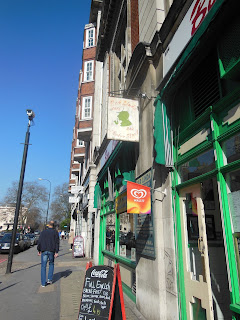“After breakfast, my dear Watson. Remember
that I have breathed thirty miles of Surrey air this morning. I suppose that
there has been no answer from my cabman advertisement? Well, well, we cannot
expect to score every time.”
The table was all laid, and just as I was
about to ring Mrs. Hudson entered with the tea and coffee. A few minutes later
she brought in three covers, and we all drew up to the table, Holmes ravenous,
I curious, and Phelps in the gloomiest state of depression.
“Mrs. Hudson has risen to the occasion,”
said Holmes, uncovering a dish of curried chicken. “Her cuisine is a little
limited, but she has as good an idea of breakfast as a Scotch-woman. What have
you here, Watson?”
“Ham and eggs,” I answered.
“Good! What are you going to take, Mr.
Phelps—curried fowl or eggs, or will you help yourself?” (“The Naval Treaty”)
(Sidney Paget, Phelps raised the cover, Creadit for Internet Archive)
In the illustration of Paget, it is difficult to find the curried fowl dishes. It might be still covered or the one in front of Holmes. It seems that Paget does not illustrate the food clearly because it is not the most important point in this illustration. We can see Watson and Mr Phelps's surprised face clearly. Therefore it seems that Paget would like to emphasises their surprise with this illustration.
When the readers see Holmes’s meal, it is
often “breakfast”. In this case, Holmes went out to investigate and gets back
after he solved it in the morning. Holmes seems to be so excited about the
breakfast but actually he is excited “the blue-gray paper”, which his client
was looking for, on the dish. It help to emphasise his biggest interest is the
case not eating and Doyle uses the descriptions of food and eating to express
Holmes’s personality.
When I read it first time, I was confused
about Mrs Hudson. I thought she is “a landlady” of 221B Baker Street, Holmes’s
flat but what she is doing here is like a housekeeper. As Holmes says that “[h]er
cuisine is a little limited”, it helps to see Mrs Hudson serves the meals for
Holmes usually. There is no detailed description about Mrs Hudson, however we
can see her personality from those conversation between Mrs Hudson and Watson.
“No, sir. He has gone to his room, sir. Do you
know, sir,” sinking her voice into animpresive whisper, “I am afraid for his
health.”
“Why so, Mrs Hudson?”
“Well, he’s that strange, sir. After you
was gone he walked and he walked, up and down, and up and down, until I was
weary of the sound of his footstep. Then I hear him talking to himself and
muttering, and every time the bell rang out he came on the stairhead, with “What
is that, Mrs Hudson?” And now he has slammed off to his room, but I can hear
him walking away the same as ever. I hope he’s not going to be ill, sir”
(Sign, 90)
Therefore, I think she is the landlady but
she takes care of Holmes by her kindness and she serves ham and eggs, and curried
fowl for breakfast this time.
When I read this narrative in Japanese,
curried fowl was translated “chicken curry”. So I imagined like this type of
curry. It is Japanese curry, and I think some people familiar with this curry
as Katsu curry?
However, I know it should be a curry in Victorian Era in
England. According to English Heritage,
“Curry was almost as popular in the
Victorian era as it is today thanks to Queen Victoria’s penchant for this spicy
dish. Food blogger Sam Bilton investigates the origins of this classic Indian
dish. Britain has had a foothold in India since 1600 thanks to the East India
Company. Long term British residents in India became known as Anglo-Indians. As
stories of the exotic food eaten by the Anglo-Indians filtered back home so the
interest in Eastern culture grew, particularly during the 19th century”.
I was not familiar with Indian food when I was
in Japan. I know there are many Indian restraint in my city, Yokohama, but I
have tried one or twice in 18 years. I was surprised when I found so many kind
of curry sauce in grocery store in London. Honestly I hesitated to try them
because they are unfamiliar for me. I have been in London for about three years
and now I like Indian curry.
It is one of my favourite Indian curries. I
suppose Holmes’s breakfast is one of these kinds of Indian curries.









